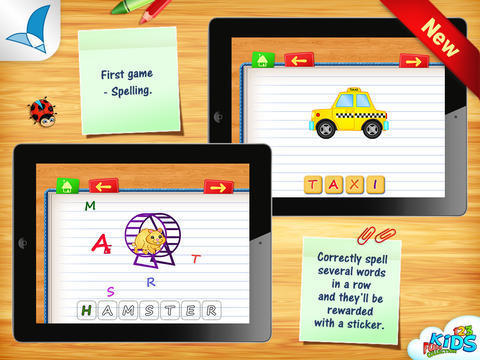Erik Qualman's Blog, page 612
February 17, 2014
iPad Educational Apps – New Trend to Teach Kids

The use of technology in education has been more of a boon than bane. Although there are unending debates about the adverse effects of the same, it is now proven in many ways that the use of technology as in mobile applications make learning more interactive and entertaining.
As such educational app for kids if used as a form of constructive engagement tool can prove to be far many times productive than you engaging the services of a babysitter. Parents can nowadays choose from a plethora of apps to help their kids develop reading, learning, concentration and various other skills.
Studies have shown that it is not only kids that benefit from mobile apps, even kindergarten teachers, day-care and parents benefit from using educational apps. Mobile learning is considered to be much more sustainable than conventional learning, since it usually incorporates a lot of pencil and paper work. However, learning on a mobile app is much more interactive, elaborate, accurate and most of all – DIGITAL.
Top 5 Educational iPad Apps for Kids
 iLearnForKids is a ‘free’ fun learning game developed by VITEB, which is intended at teaching alphabets and numbers to young kids while playing. Basically a character recognition game, this app developed especially for toddlers and pre-schoolers helps kids recognize capital letters, small letters and numbers. This requires you to simultaneously look at the randomly ‘falling’ characters and tap the same on the custom virtual keyboard (on the playscreen) to score in real time.
iLearnForKids is a ‘free’ fun learning game developed by VITEB, which is intended at teaching alphabets and numbers to young kids while playing. Basically a character recognition game, this app developed especially for toddlers and pre-schoolers helps kids recognize capital letters, small letters and numbers. This requires you to simultaneously look at the randomly ‘falling’ characters and tap the same on the custom virtual keyboard (on the playscreen) to score in real time.
The learning experience is transformed into fun and challenge as your child make every attempt to better their score and in the process enhance their concentration skills as well as motor skills (eye-hand co-ordination). Also, the app makes for a visual delight for kids with 3 background themes to choose from and delightful audio to keep kids chirpy.
 This app built especially for children in the age group of 3 to 7, is a combination of letters with pictures. Here the app is designed with the intention of starting a learning adventure to quickly and enjoyably learn alphabets while playing the interactive games.
This app built especially for children in the age group of 3 to 7, is a combination of letters with pictures. Here the app is designed with the intention of starting a learning adventure to quickly and enjoyably learn alphabets while playing the interactive games.
The 123 Kids Fun Alphabet app is designed to allow kids learn alphabets without assistance. While the first game deals with spelling, where you need to correctly spell several words in a row – to be rewarded with a sticker; the 2nd game teaches your child to point at letters. Here a voice requests your child to listen, recognise and tap a specific letter. There again is a 3rd game that teaches your child to write, while playing a fun game. The best part of this app is that here are no confusing menus or navigation – just, bright and colourful designs that kids will love.
3. Talking Numbers Free – Easy math for kids
 This fun learning app skilfully teaches your children 1-2-3 with Talking Numbers. Not only does this interactive game teaches children how to recognize the numbers from 1 to 10, the app also helps them learn to count and identify group of objects by the number of the items they have. Moreover, the app also allows your children to test their knowledge of the first ten numbers through catchy quizzes and tests, including “Fill the spaces” and “Connect the dots” with numbers from 1 to 10 to compose 15 wonderful images.
This fun learning app skilfully teaches your children 1-2-3 with Talking Numbers. Not only does this interactive game teaches children how to recognize the numbers from 1 to 10, the app also helps them learn to count and identify group of objects by the number of the items they have. Moreover, the app also allows your children to test their knowledge of the first ten numbers through catchy quizzes and tests, including “Fill the spaces” and “Connect the dots” with numbers from 1 to 10 to compose 15 wonderful images.
4. The Greengrocer – Coloring and Puzzles for Kids
 The Greengrocer app of coloring and puzzles for kids is a wonderful fun learning game with interactive background that teach children to learn with fun and identify the common fruits and vegetables. Moreover, the children will love to discover all the interactive objects in the background, and there are drawings to color. While there are 19 puzzles in the Full Version of which you can paint all the Figures; in the Lite Version there are 5 puzzles. The new version has the feature Talking Fruits, where children need to listen to the pronunciation of fruits and vegetables and repeat to learn them quickly.
The Greengrocer app of coloring and puzzles for kids is a wonderful fun learning game with interactive background that teach children to learn with fun and identify the common fruits and vegetables. Moreover, the children will love to discover all the interactive objects in the background, and there are drawings to color. While there are 19 puzzles in the Full Version of which you can paint all the Figures; in the Lite Version there are 5 puzzles. The new version has the feature Talking Fruits, where children need to listen to the pronunciation of fruits and vegetables and repeat to learn them quickly.
5. Kids Match
 Kids Match app for iPad is an adaptive, fun memory game that comprises of 8 Categories of intuitive, engaging, addictive, educational matching games with HD graphics and sounds. This interactive game for children of all ages contains an amazing and unique collection of images and sounds. This custom-made app is carefully built to fit the needs of small children, with more than 150 unique items and first words.
Kids Match app for iPad is an adaptive, fun memory game that comprises of 8 Categories of intuitive, engaging, addictive, educational matching games with HD graphics and sounds. This interactive game for children of all ages contains an amazing and unique collection of images and sounds. This custom-made app is carefully built to fit the needs of small children, with more than 150 unique items and first words.
From teaching spelling and vocabulary, to high quality images and sounds; the app has adaptive level system, which makes the game become more challenging as you pass more stages. All you need to do is ‘Shake to Shuffle’, so as to make the game more challenging and exciting for kids. This app is ‘free’ in the First 2 levels; and for all other levels, you need to avail a single in-app purchase inside the app.
Which is your favourite educational iPad app for kids?
[image error]
February 14, 2014
College Athletics: A Fuel for the Social Media Fire

Social Media has spread into nearly every aspect of college life. In the far-reaching, financially viable, much ballyhooed, and deeply scrutinized realm of College Athletics, Social Media is blazing like a fire. As a few controversies over the last few years demonstrate, the fire has started, and yes, the fire rises.
When Posts Outpace Pragmatism
Among the thousands of innocuous tweets, non-controversial Facebook posts, and innocent Instagram photos by the majority of student athletes, social media isn’t a problem. When tweets or posts capture athletes in the middle of a community service project, visiting a hospital, or in a glorious competitive moment, then social media is certainly a desirable medium for college athletics. At the other end of the spectrum, there have been firestorms associated with posts by a few athletes who didn’t apply standards of education, thoughtfulness, or common sense. The resulting negative media coverage for athletic programs has left some coaches and compliance officials scrambling to recover from the fallout. A few examples of less than desirable student athlete social media incidents include:
In 2012, The University of North Alabama removed a football player after a racially charged tweet directed at President Obama;
The University of Michigan abruptly ended their recruitment of a top New Jersey football prospect in 2012 due to a series of lewd and misogynistic tweets that drew national attention;
In 2011, former University of Minnesota men’s basketball player Trevor Mbakwe was arrested for violating a restraining order by sending a Facebook post to a woman. Aside from his other legal troubles, Mbakwe also drew national attention for a controversial 2012 Twitter post in which he proclaimed he would repay his scholarship if his team didn’t make the NCAA Tournament;
A long and painful investigation at the University of North Carolina that led to the firing of Head Football Coach Butch Davis, the resignation of the University’s Chancellor, discovery of shockingly broad and far-reaching academic fraud going back nearly twenty years, and finding of “impermissible benefits” being showered on players by sports agents all began with a series of tweets from former football player Marvin Austin in 2010;
Cardale Jones, a backup quarterback at The Ohio State University lives in infamy because of a 2012 tweet in which he described attending classes as pointless for football players; and
In February 2014, just before the publication of this article, Sam Wheeler, a wrestler from Kent State University was indefinitely suspended after a series of offensive tweets using gay slurs. Wheeler’s inappropriate social media rants were about the recent announcement by University of Missouri football player Michael Sam. Sam, who is a potential National Football League (NFL) first round draft pick, announced that he is gay.
Does Prevention Breed Responsibility?
After having direct experience with mishaps such as those described above, college athletics has witnessed a myriad of responses. Some programs, wanting to avoid the public peril that poor social media decisions by athletes can generate, have taken the approach to ban use of social media outright among their teams.
In 2011, South Carolina Football Coach Steve Spurrier banned his team from using Twitter after a series of player mishaps on social media drew unflattering attention to the program regarding student athlete behavior after incorrectly accusing players of being arrested by police;
Prior to the 2013 season, Florida State University’s football players started a team initiated ban on Twitter, Facebook, & Instagram. The team felt the ban would “eliminate clutter” and distractions like they experienced prior to a 2012 ban on Twitter instituted by head coach Jimbo Fisher;
In 2011, former New Mexico Men’s Basketball Coach Steve Alford banned his players and new recruits from having a twitter account; and
Former Boise State Football Head Coach Chris Peterson banned his team from using Twitter in 2010 and dangled removal of other social media forums for the rest of his tenure. However, new Boise State Coach Bryan Harsin has allowed his team to use twitter since he became coach in December of 2013.
Educative Practices Versus Punitive Policies
On my campus, we have avoided any major social media faux pas from our athletes. I largely credit this to the active role that our coaches and Athletic Director play in engaging our athletes, who are an overall positive and responsible group of students. Instead of taking a punitive approach to restrict social media, our Athletic Department leadership is requiring all of our student athletes to participate in a session on digital identity when one of the nation’s leading experts on social media in higher education, Eric Stoller, visits later this month. The value in this type of educational approach is that as social media forums change frequently, there is consistent learning that stays on pace with the rapid growth by teaching responsibility. An effective way to defeat the many arguments about the constitutionality of social media bans and possible controversy is to focus on educating players and establishing creative systems to monitor online behavior after setting clear standards.
In 2012, two of college athletics’ greatest rivals, the University of Louisville and the University of Kentucky shared headlines for utilizing software that monitors their athletes on social media. The auto-tracking software used by each university monitors hundreds of restricted words and expressions on Twitter, Facebook, YouTube and MySpace for their student athlete accounts.
Companies such as UDiligence and Varsity Monitor (formerly Centrix Social) monitor inappropriate social media use. In the company’s website description, UDiligence offers services to continuously monitor student athlete’s social networks for “careless social network posts” that may cause damaging and embarrassing media coverage, or damage a student, coach, or athletic director’s reputation. UDiligence claims that their company “performs the social network monitoring tasks more efficiently and effectively than an army of grad assistants, interns or assistant coaches could ever hope to by providing 24/7/365 coverage.”
Varsity Monitor describes its social media education as “on-site and web-based education on athlete social media use for leading athletic departments and teams across the country.” Varsity Monitor offers athletes the “tools they need to maximize social media opportunities while giving athletic administrators the tools they need to perpetually educate their athletes.”
A few campuses have excellent examples of infusing social media into their athletic operation, while offering policies that rest on educating and setting clear standards for student athletes. A few highlights include:
The University of Louisville’s Athletic Program offers GoCards.com, which is a social media hub to connect to all the University’s official athletic pages and twitter pages for their coaches. The University of Florida has a similar athletics social media hub;
The regrettable tweet mentioned above by Ohio State football player Cardale Jones is also the subject in a Freshman Experience Textbook at the University of Mississippi. In a First Year Experience Course that offers best practice points on how to transition to college, including proper social media behavior, Jones is included as an example of behavior to avoid;
The University of Michigan implemented a controversial social media policy in 2012 that requires athletes to give all social media account information to the Athletics compliance office;
In addition to a specific athletics social media policy at Vanderbilt University, there is also a comprehensive how-to (and how not to) social media guide that applies to their entire campus community;
In 2011, The University of North Carolina took an educative approach after the issues in 2010 by introducing a Social Media Policy for Athletes which outlines detailed examples of unacceptable behavior and delineates very specific punishments for failure to comply; and
This presentation from the NCAA National Convention offers Social Media Best Practices & Strategies for Athletic Departments.
Conclusion
The outcomes from a 2013 College Sports Information Directors of America survey offer a robust look at how colleges and universities are training student athletes and coaches on social media. Among the report’s findings, 56% of member institutions that completed the survey do not offer social media training for their student athletes while at the same time over half have had to remove a student athlete or coach’s social media post.
This survey demonstrates the need for expansive efforts in training, education, and clear policies about social media in college athletics. While there is not one perfect answer for all social media challenges, my recommendation is to develop a policy based on education and a system of monitoring that helps athletes and coaches avoid the post that could become a nightmare. I am certain that most coaches, athletes, and compliance administrators who have experienced backlash, embarrassment, and negative attention due to poor social media choices would agree, put the fire out before it begins.
[image error]
Roll Call: 6 Most Influential Tech Company CEOs of 2013

Year after year it seems like the headlines always read the same: huge growth in the tech industry. Well, 2013 was no exception. However, though prodigies Mark Zuckerberg get a lot of press, other tech CEOs are doing things that are just as amazing and noteworthy.
These creative and driven men and women don’t always get the recognition they deserve, so let’s take a moment for a quick roll call. Here are six of the most influential tech company CEOs of 2013.
Jeff Bezos, Amazon CEO
Do you remember when Amazon only sold books?
Neither do I.
Amazon is now an e-commerce giant that sells nearly anything you could possibly want. In the third quarter of 2013 Amazon’s netted $17.1 billion in sales and reported an increase of 19 percent in active users.
These numbers could grow even more impressively if the smartphone Amazon is developing with HTC takes off. Although the business phone systems market is a little more competitive than the e-reader market, if Amazon’s success with the Kindle is anything to judge by, their new phone is going to do very well.
Dick Costolo, Twitter CEO
Despite the challenges that come when a tech CEO takes over for a company’s founders, especially when those founders remain on the board, Dick Costolo has more than proven his leadership ability in his last three years at Twitter. Under Costolo’s guidance revenues have soared from $28 million in 2010 to $254 million in the first half of 2013.
Combine this impressive growth with the fact that Twitter’s IPO (Initial Public Offering) was priced at $26, but the first sale was $45.10, and you know someone’s doing his job right.
Marissa Mayer, Yahoo CEO
Marissa Mayer inherited a royal mess when she took the post of Yahoo CEO, a company that’s been floundering under its previous six leaders. However, it was a mess with plenty of potential – potential Mayer seems intent on developing.
Since her appointment, Mayer has overseen 17 major acquisitions – including the popular micro-blogging site Tumblr. She also overhauled Flickr and had Yahoo’s homepage (and logo) redesigned.
Mayer warned the press not to expect growth in 2014, as she’s focusing on getting Yahoo’s product lineup right instead of spending money on advertising. We’ll have to wait and see how things turn out, but there’s no doubt that Marissa Mayer has vision.
Larry Page, Google CEO
No list of influential tech CEOs would be complete without Google CEO, Larry Page, who is quickly becoming one of the world’s most powerful people.
Last year Google generated a whopping $18 billion in profits – profits that Page has no scruples spending on things like: acquiring Motorola, Google Fiber, Google Glass, self driving cars, and other “Moon Shots.”
Jeff Weiner, LinkedIn CEO
After joining the company in 2008, Weiner grew LinkedIn’s membership from 33 million to 225 million. Many of these new members joined because Weiner had the minimum age lowered and oversaw the creation of a new product called “University Pages,” which aims at potential college-aged users.
Weiner also brought a new focus to LinkedIn’s mobile app. In the last three years LinkedIn’s revenue has increased ten-fold (literally), and its IPO has more than tripled.
Ginni Rometty, IBM
Rometty is IBM’s first female CEO and the first woman to be invited to the Augusta National Golf Club (a notorious all-men club). Under her leadership, IBM is going into underserved markets, like Africa, which will give them a significant head start as those markets begin to develop.
Rometty is also putting a lot of resources into IBM’s supercomputer, Watson, which won Jeopardy a few years ago. However, Watson does more than play game shows. It absorbs new information at an incredible rate, and is beginning to diagnose and fight cancer. Still, Watson’s potential seems barely tapped, and Rometty says the best is yet to come.
We live in exciting times – thanks in part to men and women like those on this list. Let’s just take a moment to marvel at how far we’ve come in the last year, and anticipate what’s to come in 2014!
[image error]
Free Socialnomics Lesson Plan: Showing our LOVE for educators

 Happy Valentines Day! Today we are showing our love for all those educators that are teaching students about social media, digital citizenship and empowering students to be digital leaders. This post is jam packed with resources and stats, as well as a link to your free copy of our Socialnomics Learning Lab.
Happy Valentines Day! Today we are showing our love for all those educators that are teaching students about social media, digital citizenship and empowering students to be digital leaders. This post is jam packed with resources and stats, as well as a link to your free copy of our Socialnomics Learning Lab.
To start things off here are a few WOW stats about the state of digital and tech in education.
The online learning enrollment growth rate is 14x the growth rate of overall higher education enrollment. (http://www.knewton.com/digital-education/)
There are over 20,000 education specific apps now available. (http://edtechreview.in/news/792-the-digital-classroom-infographic)
This academic year it is projected that 81% of post-secondary students will take some or all of their classes online. (http://www.knewton.com/digital-education/)
96% of students with internet access are using social networking sites (http://gettingsmart.com/2014/01/ways-implement-safe-social-media-schools/)
96% of teachers believe that using technology in a classroom increases student engagement. (http://www.weareteachers.com/hot-topics/topics-in-education/the-digital-classroom-2013)
We’ve curated a few great ‘how-to’ posts for the digital leaders in education…
How to Create a Class Podcast in 5 Easy Steps http://buff.ly/1gqOR3a
The Innovative Educator: How to showcase #TeacherEffectiveness using digital portfolios http://buff.ly/1gqQtKk
A Simple Way To Introduce Your Students To Coding http://buff.ly/1m8EW7S
Ways to Implement Safe Social Media for Schools http://buff.ly/1gqSDcG
How To Create Dynamic Learning Environments Using Gamification – Edudemic http://buff.ly/1m8GuyK
And now for the grand finale, check out the BRAND NEW Socialnomics Learning Lab! It was designed to accompany the Socialnomics textbook. Socialnomics is being used as a textbook at over 100 universities! This is our way of saying THANK YOU for using Socialnomics, we hope this learning lab helps to engage your students in a very important dialogue about digital citizenship!
Socialnomics Learning Lab
If you are interested in using Socialnomics, Digital Leader or What Happens in Vegas Stays on YouTube as a common reader for your incoming class, your students, or for faculty/staff, please contact us at socialnomics@gmail.com to discuss our bulk ordering options! Also, if you are using any of Erik’s books currently in your class and are interested in him Skyping in to the class, email us at Socialnomics@gmail.com to set up a Skype chat!
[image error]
February 13, 2014
Adopting Social Media in Finding a Child

 Social media is not only a place to connect with friends, but it’s become an online forum for most any need or support these days.
Social media is not only a place to connect with friends, but it’s become an online forum for most any need or support these days.
For those in the adoption process and looking for connections, whether they are support from others, information, or possibly actually finding that baby, social media can be an important place to be.
According to adoptionplace.org, there have been more than 2 million adopted children since 2000 in the United States.
Domestic adoptions are on the rise and whether it’s through foster care, private organizations, nationally or internationally, it is can be an emotional journey throughout the process.
Who is Adopting?
Statistics show that while more than 52% of couples adopt due to infertility, many adopt to have a sibling for a biological child and also single parents and gay and lesbian couples are look to adopting to become parents as well.
Why Use Social Media?
Social media is a broad base where adoptive parents can find support from friends, information from groups, and possible links to the child they’ve been looking for.
This isn’t something to go into without prior research, and from questions like how long are adoption agency waiting periods to what’s the difference between open and closed adoptions, perspective parents can find lots of information on social media.
Those looking to adopt can use social networking sites like Facebook to find information and support about adoption.
Some choose to start a separate page dedicated to their search for a child.
Here they can post pictures of themselves, extended families, discuss hobbies, careers, and why they want to be parents. It’s a great way to have a ready reference. Friends can also chime in about the great qualities these parents to be may possess.
Be Careful…
• If using Facebook and other social media, make sure your personal page is one that you’d be proud for any agency or perspective birth family to take a look at.
• Also, make sure things are legitimate before getting too excited or offering up too much personal information. We all know there are those out there who can take advantage, and no one wants to get caught up in that.
• Make sure you know the basic rules, laws, and guidelines of adoption before taking too much on yourself.
Other Social Sites
Besides the biggies in the social media world, look for some social media sites to connect with others looking to adopt, or perhaps places where you could find a child to adopt.
These sites offer places where families can post a profile and connect with other families. They can also find support from others in the same position, or those who have already successfully adopted, read valuable blog posts and much more.
Adopting a child can lead to an an exciting, nerve-wracking, emotional time.
There will be ups and downs, highs and lows, but if all goes well, soon enough a child of our own will be the end result.
Photo credit: smartparentingadvice.com
[image error]
Get in Gear with Social Media to Find Teen’s Car

 If your teen just went from a learner’s permit to a driver’s license, then it’s probably time to add another car to the family.
If your teen just went from a learner’s permit to a driver’s license, then it’s probably time to add another car to the family.
Before you walk through every car lot in town looking for the perfect vehicle for your teen, social media sites like Facebook and Twitter can help you with your car buying endeavors.
Here are just a few examples of how car manufacturers are getting social as well as ways you can use social media when it comes to getting your teen behind the wheel of a new car.
Car Manufacturers and Social Media
Social media is a part of just about everyone’s life, so it’s no wonder car manufacturers of all makes and models are gathering a following on social sites.
Not only is social media a great way for car companies to connect with potential customers and answer questions, it also helps manufacturers and even independent dealers build brand recognition.
When it comes to car companies reaching out to the social media masses, here are just a few examples of which brands are doing it the best:
• Buick – In an attempt to brush off the stereotype that Buick’s are only for seniors, Buick took to social media creating a digital scavenger hunt. Buick left clues on Facebook and Twitter with hints to 42 keys hidden in different cities across the country. Social followers lucky enough to find the keys grabbed prizes including cash and the grand prize: a new Buick.
• Ford – To spread the word about the new Focus, Ford sent six driving teams cross-country with different road challenges along the way. Ford got Facebook involved by asking followers to participate in the journey by providing the Focus driving teams with clues and route tips.
• Chrysler – In an ingenious social media marketing approach, Chrysler released photos of its 2011-model lineup in mid-2010 on Facebook and Twitter. It created a ton of buzz and now Chrysler does it every year to get followers excited about the upcoming model year.
Social Outreach
Car manufacturers are using social media to stay connected to followers just as you would your friends and family.
Whether car brands use their social channels to inform you on the 6 best cars for your teen driver or to keep you updated on the latest safety features of their models, manufacturers are reaching out like never before thanks to social media.
Likewise, more and more car manufacturers on both a national and local level are creating Facebook fan pages in order to stay connected with current and potential customers, answer questions, and inform followers on brand updates. Fan pages are an especially useful resource for first-time teen drivers who already use social sites on a regular basis.
Using Social Media as an Automotive Resource
With the number of car manufacturers actively using social media, social sites have become an automotive resource for those looking to buy a new car.
Here are a couple ways you can use social media when making your new car decision:
• The Manufacturer’s Presence – First, check social sites like Twitter and Facebook to see whether the manufacturer has a social presence. Most manufacturers will, but local dealers might not. Social media really comes in handy with local dealers in terms of what others are saying about them and what kind of following they have.
• Opinions – Using your friends and family as a resource is a great way to take advantage of social media during the car buying experience. You can post questions to your Facebook and Twitter accounts asking friends and family which car they bought their teens.
• Social Advertising – Car manufacturers use social media as an advertising platform just as much as a way to stay connected. Because of this, social media is also a great way to find out which manufacturers and local dealerships offer the best deals, like year-end discounts for example.
When it comes time to find a new car for your teen driver, let social media steer you in the right direction.
Photo credit: teendriversource.org
[image error]
February 12, 2014
Major in the Right College Choices

 Choosing a college major is one of the toughest decisions you’ll ever make.
Choosing a college major is one of the toughest decisions you’ll ever make.
It determines the type of career you’ll have, the salary you’ll make and how you’ll be spending your work days throughout your life. Do you want to work in an office or perhaps in a hospital? Do you like working with numbers or prefer to be creative? Is upward mobility important to you?
All of these questions, and more, must be asked.
How to choose the right major
Picking a major is just as important as picking a college.
In order to choose a major that’s best-suited for you, there are a few things to consider:
Know your interests – Make a list of all of your interests, hobbies, likes and dislikes. Think about how you spend your free time. Do you spend it socializing, problem solving, tackling projects or helping others? You’ll never work a day in your life if you love what you do. Do something you love and would be willing to do for free.
Know what you’re good at – If you’re bad at math, accounting may not be the route you want to take. If you’re good at helping others, a career in medicine may be for you. Combine your likes and passions with what you’re good at to help you determine your major.
Get experience – Talk to everyone you know in your field of interest and ask plenty of questions. Just because you like math doesn’t necessarily mean accounting is the path you should take. See if you can shadow someone for a day to get a feel for the ins and outs of the job. Learn as much as you can about the profession before deciding on a major. Deciding how to choose a college major you can live with is best done by talking to people and seeing what the field is really about.
How social media can help
Surprisingly, social media can actually play a positive role in helping you choose a major and a school.
You can connect with others who are majoring in your field of interest and see what they have to say about the program. You can read blog posts; follow the school on Twitter and ‘like’ their Facebook page to learn as much as you can.
To successfully utilize social media, the school needs to be able to connect with the students and engage in conversation. If a student has a question regarding a certain major or program, they should be able to ask over a social media platform and get a response within a few days.
Ideally, universities want their social media presence to be credible and positive. They want potential students to trust the information and feel they can refer to it for relevant information.
The Guardian and The Student Room found that even though most students use social media multiple times per day, they usually aren’t even aware that their college of choice uses social media. The challenge for universities is to be more informative on social media so prospective students will feel confident in using it.
Universities should have such a social presence that they can actually recruit students via social media.
They can Tweet about upcoming online courses, when to register for classes, upcoming sporting events and more. Social media should be where current and prospective students turn to find the latest information on their school and major.
Top majors
The Princeton Review found the most popular college majors that students are choosing.
The top five, beginning with number five, are education, biology, nursing, psychology and the number one college major today is business administration.
Given its rising popularity, you may one day see social media crack that list.
Photo credit: Forbes.com
[image error]
February 11, 2014
Blog Makeovers: Tips for interesting content that will drive customers straight to your brand


Cear copy, lists and tips, and clear call-to-actions are the craze this year to give your eContent a 2014 makeover!
These days, when people have a question, they turn to the internet. Consumers routinely enter their questions, and Google answers it with a blog or eBook. It’s like magic. Marketers know this and are looking to better understand how to develop content that will help drive consumers to their products and services. Social Media Examiner’s 2013 social media study found that 58 percent of marketers are blogging, 62 percent want to learn more about it and 66 percent plan on increasing blogging activities.
In general, eContent is about connecting with customers and providing help around a topic related to an industry, therefore instilling brand loyalty. It’s not about direct selling. Offering up information is a great way to get consumers to take a closer look at a product or service and try it.
For example, if you’re a hardware store, you might create content around fixing a leaky pipe, preparing a wall for painting or installing a kitchen sink. A hospital might publish tips for a healthy diet, information on vaccinations or signs for when it’s time to go to an emergency room.
If you are The New Yorker Hotel you publish eBooks on things to do and sights to see while in New York City. Their strategy earmarks eContent to improve SEO rankings and increase traffic, conversions and revenue. “We’re in the most competitive market in the world,” says John Yazbeck, director of sales and marketing for the hotel. “Our eContent efforts have made a marked improvement.”
Indeed they have. Using a patented social software listening tool for Twitter that constantly looks for opportunities to put content in the hands of travelers, they’ve generated more than 800 conversations which lead to 337 prospects over a four-month period, most of which came from the blog.
Blog or eBook? Most people understand that a blog is a short, regularly published post written by an expert offering information or provoking thought. An eBook is an evolution of a white paper, but significantly more user friendly with graphics that help tell a story and move a reader along. For instance, The New Yorker Hotel has gotten great mileage from their New York travel tips eBook.
What does effective content look like? Here is a five-part checklist that can help businesses make sure that eContent survives the acid test in order to publish information that instills brand loyalty and drives consumers toward brand.
Crisp, concise content. In the age of tweets and text messages, people are looking for information, and they want it quick. Make sure your blogs don’t get too lengthy. If you have more info to share, consider the way you format it. Make it easy to find information throughout if someone is just skimming your text.
Lists, tips, how to’s and questions. Blog posts and eBooks formatted in these styles receive more views, shares and “likes” on Facebook. Think of these as the modern day self-help manual.
Clear call-to-actions. Readers have read your content, now what? You must have a clear call-to-action to get them to take the next step. For example, “Liked what you read? Contact us for more info” or “Want to learn more, sign up here!”
Personality. Your content should have a “voice.” And that voice should reflect the personality of your business. You don’t want there to be any disconnect.
Relevant content. Sure, you may have an opinion on the latest election, but if your business isn’t politics, you shouldn’t talk about it. Make sure your content aligns with the overall goals of your business.
[image error]
Vampire Apps: Who Are The Winners And Losers in Sucking Your Battery Life?

Are you addicted to Candy Crush? If so, it looks like your need to level up could be sucking the life out of your battery. KS Mobile, the makers of the free Clean Master utility app for Android, announced its index of the top ten battery draining apps for Android:
10) Candy Crush Saga
9) Fruit Ninja
8) Racing Moto
7) imo free video calls and text
6) Temple Run 2
5) Zello PTT Walkie-Talkie
4) Viki: Free TV, Movies & News
3) EZ Weather Forecast & Widget
2) Outlook.com
1) Camera360 Ultimate
Battery drain can be frustrating, and if it happens at just the ‘right’ time it could really leave you stranded. If you are often running into issues with battery life on your mobile phone, there are ways to better manage your battery’s life. A Mashable post from September 2013 offered up these great tips for conserving your battery…
Keep Location Services off until you need it. Maps are a no brainer, but there are tons of apps that use your phone’s GPS to determine where you are in the world. Services like Yelp and Google Now are also going to pinpoint your location on the map, so it’s best to just keep this feature turned off until you need to figure out where you’re headed next.
Avoid apps with lots of advertisements. Games are the biggest culprit here. Those ads are constantly refreshing, sucking up your precious battery life while doing so.
Keep your 3G or 4G and Wi-Fi off when not in use. You don’t need to completely stop using your phone’s Internet connection, but if you want that battery to last all day, turn off the cell connection and Wi-Fi when you’re definitely not going to be using it, like when you’re at your desk and using your computer anyways. It’ll also eliminate those pesky phone notification every time you get a new email.
We mentioned some of the ‘losers’ when it comes to apps that are draining your battery, but what about the winners? The following apps are noted as the best mobile apps for improving battery life on your Android phone or tablet.
1. Du Battery Saver & Switch Widget
2. Easy Battery Saver
3. NQ Easy Battery Saver
4. Battery by MacroPinch
5. Battery Doctor (Battery Saver)
Want to know more about these apps? Check out this post from Heavy.com with an in-depth analysis of each app listed above. Which apps do you think are draining your battery? Do you have any suggestions for apps that save your battery?
[image error]
February 10, 2014
Reading People Through Their Web Presence

Have you ever received an email from someone where the entire message was simply in the subject line and the body of the email was left blank? What about the Facebook friend that likes anything you post within two minutes of updating your status? How are you studying someone’s virtual presence in order to better connect with them and their business style in the real world?
Successful businesses are built on relationships and relationships are built on the ability of people connecting and understanding each other. In order to give yourself the best chance of connecting with someone, use their virtual presence to have a better understanding of their hardwiring. How much attention do you pay to the hints that people are broadcasting online? Five minutes of observation and research could allow you to adapt your approach to better connect in person.
Let’s look at emails for example. If you receive email from a client or a prospective customer who you have never met before and the email is brief, to the point and could have been easily conveyed in the subject line, then they probably have a very big picture and energy driven personality type. Perhaps their email failed to use proper grammar or spell check as they just wanted to get the point across and move on to their next opportunity or task. When you meet with energy driven prospects, don’t bore them with the minute details. Get to the bottom line as they do when they communicated with you. They might not care about how your company, service or product works… they just want to know what it does and how that affects their situation. Rapport building is still essential with this group but perhaps a little less small talk than normal. Typically a half completed LinkedIn profile that only highlights accomplishments is another clue.
If the email is very methodical, in outline form and asks many questions, that should be a tip off that the client or prospect is more of an analytical type. They prefer heavy research, data and numbers to back up what you are educating them on and also take a longer time in making decisions. They could view your small talk as superficial and would prefer that you go through the details of the presentation. To speed up their decision making process or connection process, do not present too many options for them to dissect. Also make the next steps in the process very predictable and always check in on what they are thinking and what additional information they need in order to make the best decision. The analytical types will usually have very complete and by the book LinkedIn profiles.
If you get an email from someone who goes off on tangents not related completely to the business at hand, they will have a highly personal approach to business. Usually, they want extra warm up time when they first meet you and want to know more about you as a person than as a professional. The good news is you will probably leave these meetings with a new best friend if you follow their lead. The bad news is, it doesn’t mean that any business got accomplished. Spend extra time understanding who these people are and how they feel towards the business at hand. Also, don’t cheerlead too much about your product or company, but more about why you are involved. Frequently ask for their opinions and connect your proposal to how it will positively affect the people they surround themselves with. The social/personal drivers will have many friends on their networks and very active on their social networks. They have an addiction to sharing their feelings and life with the people on their networks. Also be sensitive to their decisions and encourage their opinions to build the best connection.
Every person and situation is different of course, but use these hints as general rules of thumb to enhance your connectivity in new relationships.
ABOUT:
Eddy Ricci, Jr., has been labeled as “the emerging expert in developing Gen Y sales professionals” by the chairman of Publicis Kaplan Thaler. Eddy is the director of a unique training and development collaborative platform that services financial planning firms in the northeast where he has arguably worked with more Gen Y financial professionals than anyone in the country over the past four years. He is the founder of The Growth Game, LLC. ,a professional development company and has authored a book that holds the same title. Eddy is a certified coach and specializes in helping professionals develop sales skills, leadership approaches and implement business development activity systems.WWW.THEGR OWTHGAME.COM.
[image error]



